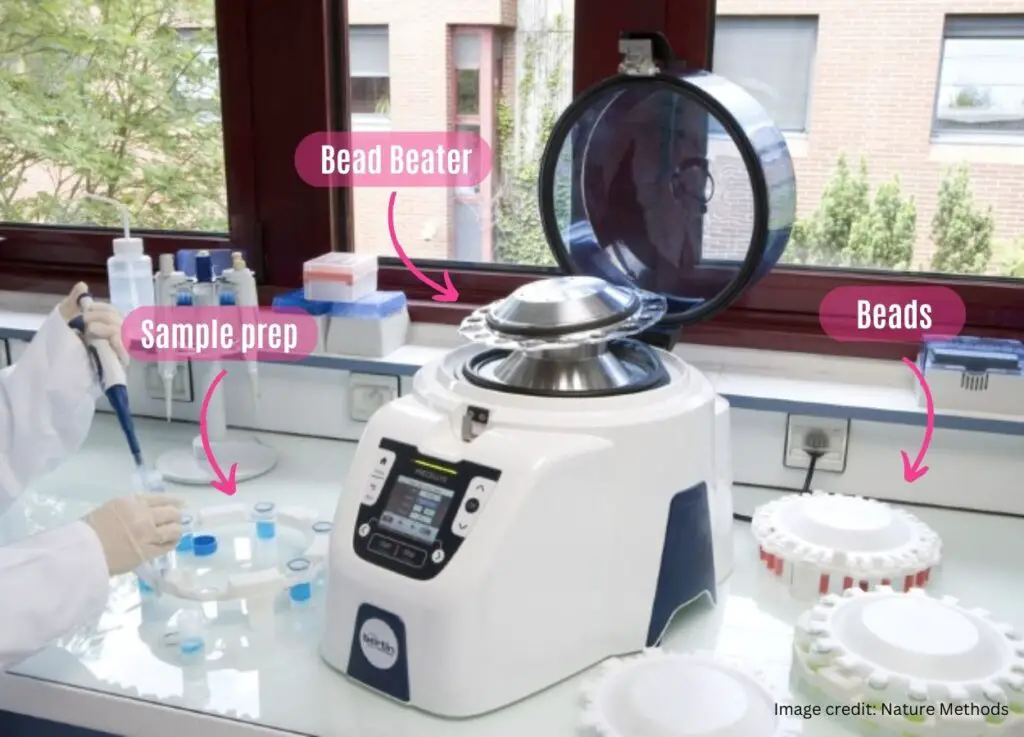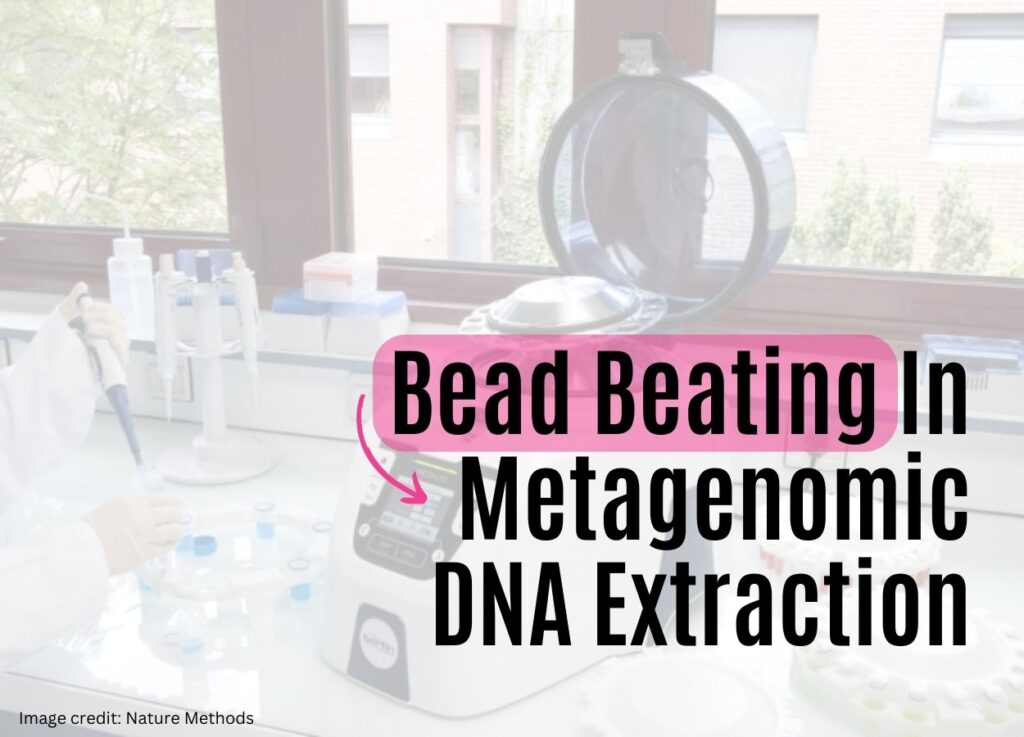“Bead-beating is a new-age mechanical tissue homogenization technique to effectively isolate DNA from microbes using beads. Metagenomic DNA extraction highly relies on the present technique. Let’s see how we can use it.”
DNA isolation is an initiation step in metagenomics analysis. Pure and high-yield DNA isn’t the only parameter for metagenomic DNA isolation. The technique should be capable enough to isolate DNA from every microbe possibly presents in the sample.
The cellular structure and composition vary among different microbes. Oftentimes, the sample possesses microbes having a complex and hard cell wall. So a single isolation technique might not be enough. In addition, DNA isolation from low-abundant microbes is an even tougher task.
Manual methods of DNA extraction and even spin-column kits directly fail in this scenario. However, one method scientists use often to obtain high-integrity DNA for metagenomic studies is bead beating. It is the most effective homogenization technique for microbial/metagenomics samples.
Let’s see the principle of the concept of bead beating and how it works. Keep in mind that the objective of writing such a type of article is to make you understand how different technology in DNA extraction and genetic studies work.
Stay tuned.
Key Topics:
What is bead beating?
Bead beating is a mechanical cell lysis procedure that lyses cells more effectively than chemical or enzymatic lysis methods. It needs only 3 things: beads or balls, media or buffer and a bead beater instrument. Buffer or media is optional.
Cell wall lysis is the first step in the nucleic acid extraction procedure. Many methods exist but the selection depends on the cell wall composition. For instance, DNA extraction from plants and any human sample can be performed by mechanical lysis (mortar and pestle) and enzymatic lysis, respectively.
Entirely converse to this, chemicals or solutions are capable enough to treat bacterial cells, so often. However, which technique would work highly depends on the cell wall composition of the ‘sample.’
Isolating DNA from microbes is a relatively easy scheme. Still, doing metagenomic DNA isolation is indeed a difficult task. The reason is, we need to extract DNA from every possible microbes- viruses, bacteria, fungi, archaea or any other prokaryote present in the sample.
Where a sample of microbes and their cell composition is still unknown, the thick cell wall of gram-positive bacteria increases the difficulty level one-fold more. So to produce optimum yield and avoid bias, effective cell lysis is required.
The bead-beating homogenization technique greatly increases the DNA extraction efficiency for metagenomic samples.
Read more: Tissue homogenization.
Principle:
Bead beating is a cell lysis step performed prior to DNA isolation. Glass or ceramic beads, which we can call small balls too, are added to the metagenomic sample along with grinding media and allowed to beat in the beater.
The beater shakes the sample, producing a collision between cells present in the sample and beads finely lyse cells.

Beads:
An important element of this technique is beads. Beads are often known as a lysing matrix. Depending on the type of sample, and final isolate we required, lysing matrices are selected. Common lysing matrices are made up of glass, silica, ceramic, stainless steel, zirconium, etc.
Beads are available in different sizes, shapes and materials which makes the lysing matrix selection a crucial step. For instance, shear force and Garnet, glass or silica beads are popularly used for DNA isolation.
Besides, the hardness and chemical composition of the lysing matrix are also considered important selection parameters too. For instance, stainless steel beads aren’t advised because they can react with acid. Take a look at the list of various types of beads and their applications.
| Beads (lysing matrix) | Characteristic | Applications |
| Silica | Low density and hardness | Lysis of microorganisms |
| Ceramic | Comparatively denser and harder | DNA isolation from animal, and plant tissues. |
| Glass | Low durability and hardness. | Used in combination with other beads to reduce shearing. |
| Stainless steel | Very dense, hard and tougher. | RNA isolation from difficult tissues. |
| Garnet | Relatively tougher and aggressive | Used for DNA isolation but not recommended for RNA isolation. |
| Zirconium | High durability and toughness. | DNA isolation. |
| Silicon carbide | High strength and low-density | RNA, protein or organelle isolation. |
Note
For metagenomic DNA isolation, we need small-sized, less aggressive, spherical-shaped, low shear and medium-impact beads. Silica, glass or ceramic bead matrix can be utilized for effective metagenomic DNA isolation including microbes like bacteria, viruses, algae, yeast, etc.
Importantly, the performance of the bead chosen should be assessed only by experimentally using it.
| Sample types | Required lysing matrix characteristics | Recommended bead types |
| Bone, plant, seeds, solid tissue and skeletal muscle | High impact and low to high shearing and angular shaped | Stainless steel, Garnet, large ceramic, zirconium oxide and silicate beads. |
| Bacteria, yeast, plant leaf, coral samples and fungi | Medium shearing and angular shaped | Ceramic, zirconium oxide and silicon carbide. |
| Bacteria, yeast, alga, mammalian cells, soil and sludge (metagenomic) | Low shearing, spherical in share and small sized. | Ceramic, glass and silica. |
Bead beater:
A bead beater is a machine or mechanism used to conduct the beating or homogenization process. Plenty of options and standard modules are now available, however, for metagenomic analysis and samples vertexing up to 3000 rpm can do the job.
I strongly advise contacting the bead/ lysing matrix manufacturer to get more information. Vertexing and harsh bead beating may shear or break DNA.
Recommendation
- Use tubes that can’t react with beads or other chemicals used during the process. Tubes made from polypropylene or polycarbonate are advised.
- The tube must not be overfilled with either buffer, sample or beads. Beads can’t work effectively, otherwise.
- Use the appropriate or recommended amount of beads depending on the sample quantity, fewer beads with a high sample volume reduce homogenization yield.
- As a general thumb rule, smaller-sized beads are strongly recommended for microbial samples containing bacteria, yeast and/or fungi.
- Sometimes, beating may produce heat– for instance, during the homogenization of hard tissues, so use cryogenic homogenization or perform under cold conditions.
- The time and speed of bead beating is also an important parameter for achieving good yield. Studies suggest that processing samples for more time fragment DNA. The ideal time for bead-beating is 2 to 5 minutes at high speed.
- Environmental samples including soil and sediments combination of various-sized glass, Zirconium and ceramic beads are used.
- For host-associated samples which include a higher amount of host cells in the sample, the combination of glass, zirconium and ceramic beads along with lysis buffer is highly recommended.
- The higher salt-containing marine metagenomic samples of surfactant-coated zirconium or glass beads can be used. Salt may interfere with the beating process.
Advantages:
Bead beating is an effective way to improve DNA yield for metagenomics samples and thus plays a significant role in metagenomics DNA isolation. Besides, it is often used in protein, lipid and metabolite isolation, and microbial culture.
Limitations:
Sample-to-sample variability is a common limitation of the present technique. The yield of DNA extract varies depending upon the speed of beating, size, shape and volume of beads, time of beating and other conditions chosen during the experiments.
Another limitation is, high-speed beating or vortexing may damage the genomic DNA too. To overcome both limitations, isolation conditions must be standardized prior to isolation.
Related article: A Guide To Next-Generation Shotgun Sequencing In Metagenomics: Technique, Advantages and Challenges.
Wrapping up:
In conclusion, bead beating is an amazing homogenization technique for DNA extraction in metagenomics samples. It helps to isolate DNA from hard, tough and unknown samples, it scales up the downstream high throughput sequencing.
This is it for this article, I hope you learned an important metagenomic lesson.


